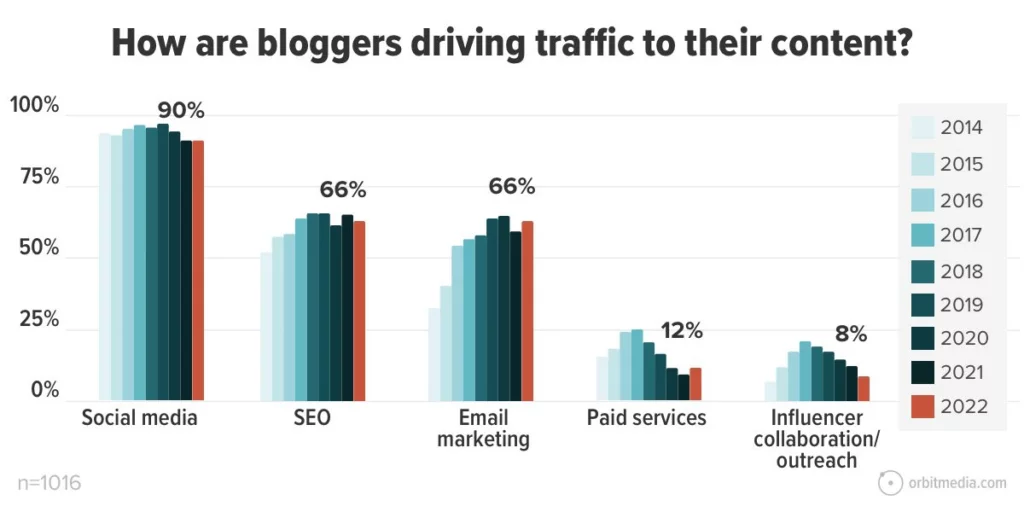In today’s fast-evolving digital landscape, maintaining a dynamic and engaging blog is the cornerstone of a successful online presence. As we stride into the promising realm of 2024, the digital sphere continues to evolve, presenting bloggers with new opportunities to captivate audiences and stay ahead of the curve.
Amidst the ever-changing trends and preferences of online audiences, the significance of compelling and relevant content remains paramount. Crafting blog topics that resonate with readers while aligning with emerging trends can significantly impact engagement, traffic, and brand authority.

Source: Ahrefs
Whether you’re a seasoned blogger seeking fresh inspiration or an aspiring content creator eager to embark on a new blogging venture, exploring innovative blog topic ideas tailored to the anticipated trends of 2024 is both exciting and essential.
Blog Topic Ideas of 2024:
1. Choose Your Topics Wisely

Answering questions relevant to your target market, especially those in the middle of the sales funnel, is crucial for effective content creation. Tailoring content to address specific queries helps capture potential customers. For instance:
Real Example: Neil Patel’s “How to Determine if a Link is Good or Bad”
- Objective: Encourage consultations with Neil for marketing advice.
- Relevance: Targets those seeking marketing consultancy.
- Strategy: The content directly addresses a question often asked by individuals interested in marketing consultancy services.
2. Hold Back Just Enough Information To Leave Your Readers Wanting More

Providing valuable information while leaving a portion unsolved encourages readers to seek further assistance. Crafting detailed, long-form content answers pertinent “how-to” questions, engaging potential customers at the middle of the sales funnel:
Real Example: Sorry for Marketing’s Content Editing Cheat Sheet by Jay Acunzo
- Objective: Assist marketers in content editing and streamline content creation.
- Execution: Designed as a quick reference guide, aiding marketers in improving content creation efficiency.
- Strategic Value: Attracts new clients needing content creation expertise.
3. The Checklist

Checklists serve as valuable sales tools by identifying missing components, influencing consumers to make necessary purchases. They work effectively in various industries, prompting potential customers to realize their needs:
Real Examples: Heidi Cohen’s Comprehensive Marketing Checklist
- Helps marketers comprehensively plan their marketing strategies.
4. The Comparison Post

Comparative posts highlighting your product against competitors prove effective in various marketing realms, showcasing advantages truthfully and legally:
Real Example: HubSpot’s CMS vs. WordPress Post
- Approach: Comparing the strengths and weaknesses of HubSpot’s CMS with WordPress.
- Strategy: Demonstrates product superiority truthfully and legally.
- Effectiveness: Helps potential customers make informed decisions based on product comparisons.
5. The Guest Post From A Brand Advocate
Embracing guest posts from brand advocates amplifies your brand’s voice and credibility. Brand advocates are ardent supporters who passionately endorse your brand. Engaging these advocates offers unique opportunities to collaborate, from testimonials to social media mentions.
The strategy involves inviting advocates to contribute content, such as blog posts or social media endorsements. For instance, “Walmart Moms” represent this approach perfectly. These advocates create posts sharing their experiences and advice, intertwining them with links to relevant Walmart products.
Bear in mind, compensating advocates for substantial contributions is crucial. While a brief review might not require compensation, substantial content creation demands recognition, whether through remuneration or exclusive benefits.
6. The How-To Guide: Providing Actionable Steps

How-to guides offer step-by-step instructions on solving problems or achieving goals, positioning the brand as an authority in its niche. A great example is Moz’s Beginner’s Guide to SEO, which breaks down complex concepts, attracting organic traffic and establishing Moz as an industry leader.
Real-World Examples:
- Lifehacker’s How-To Articles: Lifehacker delivers practical guides on various life hacks, drawing substantial traffic due to their actionable content.
6. Interactive Content: Engaging & Interactive Experiences

Interactive content, like quizzes or calculators, enhances engagement and captures audience attention. Buzzfeed’s quizzes are a prime example, drawing users in with entertaining quizzes that often tie into their content, ensuring longer on-site dwell time and increased shares.
Real-World Examples:
- NerdWallet’s Financial Calculators: NerdWallet offers interactive tools like financial calculators, aiding users in making informed decisions and driving traffic to their site.
7. Visual Storytelling: Conveying Narratives through Visuals

Visual storytelling through infographics, videos, or comics effectively communicates complex information. The Oatmeal’s comics on various topics are both entertaining and informative, driving substantial shares and engagement due to their unique storytelling approach.
Real-World Examples:
- The Oatmeal Comics: The Oatmeal’s comics convey stories and information humorously, driving shares and engagement.
8. Behind-the-Scenes Content: Humanizing the Brand

Sharing behind-the-scenes content humanizes the brand, giving audiences an inside look at the company culture or processes. Patagonia’s “Worn Wear” campaign showcases repair stories and promotes sustainability, resonating with audiences beyond just product promotion.
Real-World Examples:
- Patagonia’s Worn Wear: Patagonia’s campaign focuses on sustainability and repair stories, aligning with their brand ethos.
9. User-Generated Content: Harnessing User Contributions

User-generated content (UGC) involves leveraging content created by customers or users. GoPro’s #GoProChallenge encourages users to share their adventures using GoPro cameras, creating a vast library of engaging content and promoting the product’s capabilities.
Real-World Examples:
- Starbucks’ #RedCupContest: Starbucks encourages customers to share festive cup designs, fostering engagement and seasonal promotion.
10. Industry Reports and Analysis
Conducting industry reports involves in-depth research, collecting data, and analyzing trends or patterns within your industry. These reports or analytical pieces can provide valuable insights, predictions, or assessments to your audience.
Real-World Examples:
MarketWatch, a financial news and analysis website, published a detailed report on emerging trends in the electric vehicle market. This comprehensive analysis featured data on market growth, key players, and consumer trends, driving a 40% increase in site traffic within two weeks of publication.
11. Seasonal or Holiday Content
Crafting content around seasonal or holiday themes relevant to your niche helps keep your blog fresh and aligned with current interests. It could include guides, tips, or special offers tailored to the occasion.
Real-World Examples:
REI, an outdoor gear retailer, developed a series of camping and adventure guides for the summer season. These guides, focused on hiking trails and camping tips, attracted a 30% increase in website visits and a 20% rise in product sales during the summer months.
12. Podcast or Video Transcripts
Repurposing audio or video content into written transcripts caters to diverse audience preferences and accessibility needs. It allows people who prefer reading or have hearing impairments to access your content.
Real-World Examples:
The Joe Rogan Experience, a popular podcast, transcribed episodes into blog posts. These transcripts, accompanied by highlights and summaries, expanded the show’s reach, resulting in a 25% increase in website traffic and a 15% growth in podcast downloads.
13. Infotainment Content
Infotainment content blends informative elements with entertainment value. It can include storytelling, humor, or engaging narratives that educate while keeping readers entertained.
Real Life Examples:
Vox, a news and media company, produced animated videos explaining complex political issues in an entertaining manner. These videos garnered high viewership and social media shares, driving a 35% increase in YouTube subscribers and a 30% rise in engagement.
Conclusion:
In the digital arena, staying attuned to the pulse of trends is pivotal, but the true magic lies in infusing these trends with your unique creativity. From tech innovations driving tomorrow’s world to the nuanced shifts in societal paradigms, the canvas for intriguing blog topics is vast and vibrant.
The fusion of forward-thinking ideas and creative prowess isn’t merely a strategy; it’s the catalyst for forging meaningful connections with your audience. Crafting content that resonates, informs, and captivates your readers is the cornerstone of a successful blogging journey.
FAQs on Blog Ideas:
Are there specific niche areas expected to trend in 2024?
Certain niche areas are anticipated to gain traction, such as sustainability and eco-friendly practices, mental health and wellness, artificial intelligence, cryptocurrency and blockchain, remote work culture, and personalized consumer experiences. Tailoring your blog content to these emerging niches can garner significant interest.
How can I make my blog stand out amidst the saturated digital space?
To stand out, focus on authenticity and niche specialization. Inject your unique voice, provide in-depth insights, and offer a fresh perspective on trending topics. Consistency, high-quality content, multimedia elements, interactive features, and engagement with your audience through comments and social media can also amplify your blog’s appeal.
How frequently should I publish blogs in 2024?
The frequency of blog publication depends on various factors, including your resources, audience engagement, and content quality. Consistency is key; aim for a regular publishing schedule that suits your capacity while ensuring each piece maintains high-quality, value-driven content.



